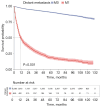Risk factors, prognostic factors and nomograms for distant metastasis in colorectal neuroendocrine neoplasms: a SEER-based study
- PMID: 40224977
- PMCID: PMC11985195
- DOI: 10.21037/tcr-24-2018
Risk factors, prognostic factors and nomograms for distant metastasis in colorectal neuroendocrine neoplasms: a SEER-based study
Abstract
Background: Distant metastasis is uncommon in colorectal neuroendocrine neoplasms (CRNENs). However, the prognosis of patients with distant metastasis is often poor, so it is crucial to detect distant metastasis in time. This article aims to study the risk factors and prognostic factors for the development of distant metastasis in patients with CRNENs and to construct two related nomograms.
Methods: Patient data were obtained through the Surveillance, Epidemiology, and End Results (SEER) database, and the inclusion population was identified according to inclusion and exclusion criteria. Logistic regression analysis was used to determine risk factors for distant metastasis in patients with CRNENs. Cox regression analysis was utilized to identify prognostic factors in patients with CRNENs with distant metastasis. Two nomograms were created and the predictive performance of the nomogram was evaluated using receiver operating characteristic (ROC) curves, the calibration curve, and decision curve analysis (DCA) curves.
Results: We included 9,142 patients with CRNENs and 859 patients with distant metastasis. Age, race, marital status, primary site, histological grade, T stage, N stage, and tumor size were independent risk factors. Age, primary site, histological grade, N stage, tumor size, dissected lymph nodes, and surgery were independent prognostic factors. The constructed nomogram can predict the occurrence and prognosis of distant metastasis in patients with CRNENs.
Conclusions: The nomogram developed in this paper may contribute to the diagnosis and prognosis of distant metastasis in patients with CRNENs and may help clinicians make better clinical decisions.
Keywords: Colorectal neuroendocrine neoplasms (CRNENs); Surveillance, Epidemiology, and End Results (SEER); distant metastasis; nomogram.
Copyright © 2025 AME Publishing Company. All rights reserved.
Conflict of interest statement
Conflicts of Interest: All authors have completed the ICMJE uniform disclosure form (available at https://tcr.amegroups.com/article/view/10.21037/tcr-24-2018/coif). The authors have no conflicts of interest to declare.
Figures











Similar articles
-
Predictive and prognostic nomogram models for liver metastasis in colorectal neuroendocrine neoplasms: a large population study.Front Endocrinol (Lausanne). 2025 Jan 7;15:1488733. doi: 10.3389/fendo.2024.1488733. eCollection 2024. Front Endocrinol (Lausanne). 2025. PMID: 39839478 Free PMC article.
-
Epidemiological trends and novel prognostic evaluation approaches of patients with stage II-IV colorectal neuroendocrine neoplasms: A population-based study with external validation.Front Endocrinol (Lausanne). 2023 Feb 1;14:1061187. doi: 10.3389/fendo.2023.1061187. eCollection 2023. Front Endocrinol (Lausanne). 2023. PMID: 36817582 Free PMC article. Clinical Trial.
-
A New Online Dynamic Nomogram: Construction and Validation of a Predictive Model for Distant Metastasis Risk and Prognosis in Patients with Gastrointestinal Stromal Tumors.J Gastrointest Surg. 2023 Jul;27(7):1429-1444. doi: 10.1007/s11605-023-05706-9. Epub 2023 May 25. J Gastrointest Surg. 2023. PMID: 37231240 Review.
-
Evaluation of Risk Factors, and Development and Validation of Prognostic Prediction Models for Distant Metastasis in Patients With Rectal Cancer: A Study Based on the SEER Database and a Chinese Population.Cancer Control. 2024 Jan-Dec;31:10732748241303650. doi: 10.1177/10732748241303650. Cancer Control. 2024. PMID: 39579008 Free PMC article.
-
Construction of web-based prediction nomogram models for cancer-specific survival in patients at stage IV of hepatocellular carcinoma depending on SEER database.Zhong Nan Da Xue Xue Bao Yi Xue Ban. 2023 Oct 28;48(10):1546-1560. doi: 10.11817/j.issn.1672-7347.2023.230040. Zhong Nan Da Xue Xue Bao Yi Xue Ban. 2023. PMID: 38432884 Free PMC article. Clinical Trial.
Cited by
-
Genetically predicted interleukin 7 levels and neuroblastoma risk combined with analysis of radiation therapy timing effects.Discov Oncol. 2025 Aug 23;16(1):1601. doi: 10.1007/s12672-025-03336-y. Discov Oncol. 2025. PMID: 40849609 Free PMC article.
References
-
- Zhang Y, Shang L, Zhang PP, et al. Clinicopathological features and prognostic validity of the European Neuroendocrine Tumor Society (ENETS) and American Joint Committee on Cancer (AJCC) 8th staging systems in colonic neuroendocrine neoplasms. Cancer Med 2019;8:5000-11. 10.1002/cam4.2370 - DOI - PMC - PubMed
LinkOut - more resources
Full Text Sources
